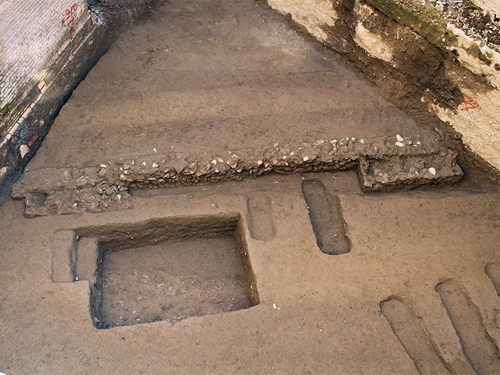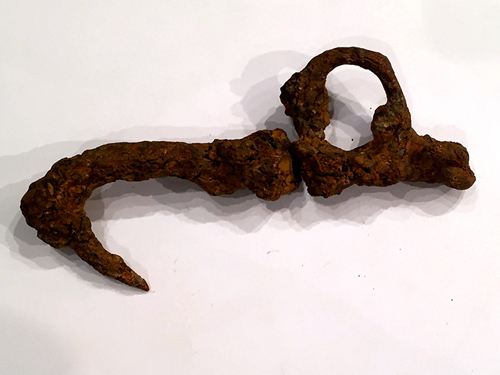
JOSEPHINE MCKENNA, of Religion News Service, reports on how recent archaeological finds are offering new insights into how Jewish people were persecuted in Rome more than 500 years ago…
Italian archaeologists have discovered the remains of 38 skeletons buried in a Jewish cemetery in Rome more than 500 years ago, offering further evidence of their ubiquity and persecution under papal rule.
The well-preserved skeletons were found during excavations beneath a building in an area identified on ancient maps as “Campus Iudeorum” – Latin for “Field of Jews” — in the Trastevere quarter of Rome just across the Tiber River from the Italian capital.

UNEARTHED: The burial area where the bodies were found during building construction in the Trastevere district of Rome. PICTURE: Rome’s Archaeological Superintendency
“I am very happy we have found important information about this cemetery, perhaps for the first time ever.”
– Daniela Rossi, archaeologist
The bodies were believed to have been buried there between the mid-14th and mid-17th centuries, and the discovery is giving archaeologists new insights into how the community lived and died in the medieval era.
“I am very happy we have found important information about this cemetery, perhaps for the first time ever,” the archaeologist in charge of the project, Daniela Rossi, told RNS. “It is testimony to the important presence of the Jewish community in earlier times.”
The skeletons were discovered during excavations about six metres beneath a large modern building undergoing renovation. Apart from the cemetery, archaeologists also found the remains of an ancient tannery at the site dating back to the era of Roman Emperor Septimius Severus in the third century.
Dr Rossi, from Rome’s Archaeological Superintendency, said the graves confirmed customary Jewish funeral practices: The bodies were buried in plain wooden caskets without any objects and were only identified after a fragment of a Hebrew epigraph was found at the dig.
She said the absence of headstones was a result of decrees issued by Pope Urban VIII, who ruled in 1625 that Jews be buried in unmarked graves and ordered headstones to be removed from existing graves.
“The only Hebrew inscription, a fragment, came from a layer where the graves were obliterated so without a doubt that was the result of Pope Urban VIII decrees in October 1625,” Dr Rossi said.
Apart from the skeletons, the only objects found were two gold rings found on a woman’s fingers and part of an iron scale attached to a man’s hand, which Dr Rossi said may have been an indication of his profession or his honesty.
Experts said the skeletons were predominantly adult males and there were few children. Scientific analysis also showed signs of a poor hygiene and inadequate diet lacking in protein.
Dr Rossi said the first recorded news about the Field of Jews on ancient maps dates back to 1363 when the Company of Death, a military corps, ordered a cemetery to be set aside on a plot of land in Trastevere.
“Certainly at other times someone would have already become aware of this (cemetery) but it was not given any attention or prominence,” Dr Rossi said.
Rome’s Jewish community has welcomed the discovery and pledged to rebury the 38 bodies with the prayers and rituals of a Jewish funeral.
“A cemetery means a lot to the collective experience of any community, to its sense of self,” said Claudio Procaccia, cultural director for Rome’s Jewish community.
“This discovery affirms the vital and vibrant presence of the Jewish community at that time. This is fundamental.”

FOUND: The hook of a balancing scale found buried and attached to the hand of one of the bodies. PICTURE: Rome’s Archaeological Superintendency.
The graves also offer new insights into the way Jews lived in the medieval era. A papal decree issued by Pope Paul IV in 1555 confined them to a walled ghetto, deprived of property rights and forced to listen to Catholic sermons.
Mr Procaccia said while the popes never expelled the Jews from Italy, the papal decree regarding unmarked graves was a sign of how the community was treated at the time.
“The ban on headstones was very serious,” he said.
On the outskirts of Rome there are Jewish catacombs that once encircled the ancient city. They are also close to some of the city’s Christian catacombs that emerged in the second and third centuries.
Discovered beneath Villa Randanini in 1859, the Jewish catacombs consist of a dark labyrinth of tunnels that stretches for nearly 200,000 square feet. Visitors can still see colorful frescoes and Hebrew epitaphs as well as depictions of menorah.
Mr Procaccia said in recent years there has been enormous growth in Rome’s Jewish community, which dates back more than 2,000 years.






